The demand for frozen food in EU is likely to grow from USD 74.6 billion in 2025 to approximately USD 125.5 billion by 2035, recording an absolute increase of USD 50.9 billion over the forecast period. This translates into a total growth of 68.2%, with the market forecast to expand at a CAGR of 5.3% between 2025 and 2035.
The market size is expected to grow by nearly 1.7X during the same period, supported by the rising demand for convenient meal solutions across European households, increasing consumer preference for extended shelf-life food products and time-saving cooking alternatives, growing adoption of advanced freezing technologies within European food manufacturing infrastructure, and expanding modern retail and cold chain distribution networks across EU member states.
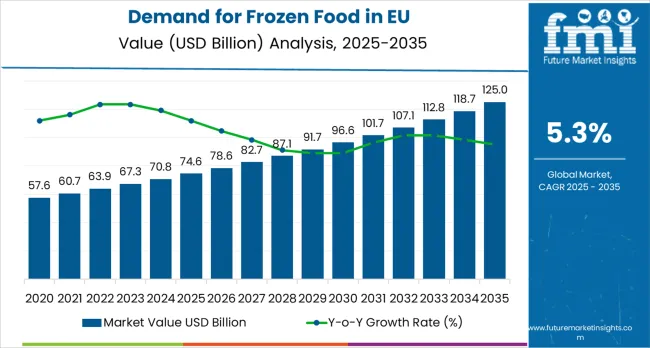
Between 2025 and 2030, the demand for frozen food in EU is projected to expand from USD 74.6 billion to USD 96.9 billion, resulting in a value increase of USD 22.3 billion, which represents 43.8% of the total forecast growth for the decade. This phase of growth will be shaped by accelerating urbanization trends across European metropolitan areas, increasing consumer demand for convenient meal solutions and time-efficient food preparation, growing adoption of premium frozen food categories including organic and health-focused products, and expansion of modern retail infrastructure and cold chain logistics in Eastern European economies. Manufacturers are developing innovative product formulations including premium ready meals, artisanal frozen foods with clean label ingredients, advanced packaging solutions for extended freshness, and sustainable freezing technologies to address evolving European consumer preferences for convenience, quality, nutritional value, and environmental responsibility.
From 2030 to 2035, the market is forecast to grow from USD 96.9 billion to USD 125 billion, adding another USD 28.6 billion, which constitutes 56.2% of the ten-year expansion. This period is expected to be characterized by widespread adoption of premium frozen food categories across mainstream European grocery chains, integration of advanced Individual Quick Freezing (IQF) technologies for superior product quality, development of innovative packaging solutions targeting sustainability and extended shelf life, and expansion of premium organic and health-conscious product segments. The growing emphasis on convenience cooking and meal planning in European nutrition systems, increasing professional nutritionist recommendations for frozen vegetables and fruits as viable healthy alternatives, stringent EU regulations supporting food safety and cold chain standards, and rising health consciousness across European consumer segments will drive sustained demand for nutritionally superior, conveniently packaged, and sustainably produced frozen food solutions.
Between 2020 and 2025, the demand for frozen food in EU experienced robust expansion, driven by accelerating lifestyle changes that positioned frozen foods as essential solutions for busy European households, meal planning optimization, and nutritional convenience. The market developed as European food manufacturers and convenience-seeking consumers recognized commercial opportunities in high-quality, premium frozen, and specialty frozen food formats that appealed to time-conscious consumers and professional food service operators seeking optimal convenience and consistent quality for their culinary applications. Major international frozen food producers expanded production capacity through strategic capital investments in European manufacturing facilities and cold chain infrastructure, while regional players developed specialized freezing techniques addressing specific taste preferences and nutritional requirements across diverse national markets within the European Union.
Market expansion is being supported by the fundamental shift in consumer lifestyles toward convenience and time-efficiency across European societies, with frozen foods increasingly regarded as essential household solutions deserving premium quality positioning, advanced preservation methods, and nutritional benefits comparable to fresh alternatives while providing unique convenience and extended shelf life advantages.
Modern European consumers and food service professionals consistently prioritize product quality, nutritional retention, convenience factors, and sustainable packaging when selecting frozen food products, driving demand for specialty frozen formulations that deliver superior taste performance, advanced freezing processes, exceptional nutritional preservation profiles, and environmental certifications compared to traditional preservation methods and processed food alternatives.
Even minor concerns about meal planning efficiency, nutritional adequacy, or food waste reduction can drive comprehensive adoption of specialized premium frozen products designed to maintain optimal nutritional status, support specific dietary applications, and enhance consumer satisfaction throughout all meal categories.
The growing complexity of modern European lifestyles and increasing awareness of food waste reduction strategies are driving demand for professionally processed frozen food products from certified European manufacturers with appropriate quality certifications, advanced freezing capabilities, technical expertise, and compliance with stringent EU food safety and cold chain regulations.
Regulatory authorities across European Union member states are increasingly establishing comprehensive guidelines for frozen food manufacturing, cold chain management standards, nutritional labeling requirements, and food safety protocols to ensure product quality and consumer safety.
Scientific research studies and nutritional analyses conducted at European food science institutions are providing evidence supporting frozen food interventions for common lifestyle challenges including meal planning optimization, nutritional consistency maintenance, food waste reduction, and dietary convenience enhancement, requiring specialized freezing expertise and quality-controlled production processes that meet EU food safety and nutritional standards.
The market is segmented by freezing technique, product type, distribution channel, and sales region. By freezing technique, the market is divided into Individual Quick Freezing (IQF), Belt Freezing, and Blast Freezing methods.
Based on product type, the market is categorized into Frozen Ready Meals, Frozen Fish & Seafood, Frozen Meat Products (including poultry, pork, and beef), Frozen Dairy, Frozen Fruits & Vegetables, Frozen Bakery, Frozen Soups & Sauces, and Others including snacks and mixed products. By distribution channel, the market spans supermarkets/hypermarkets, specialty stores, foodservice operators, and online retail platforms. Regionally, the market covers Germany, France, Italy, Spain, BENELUX, and Rest of Europe.
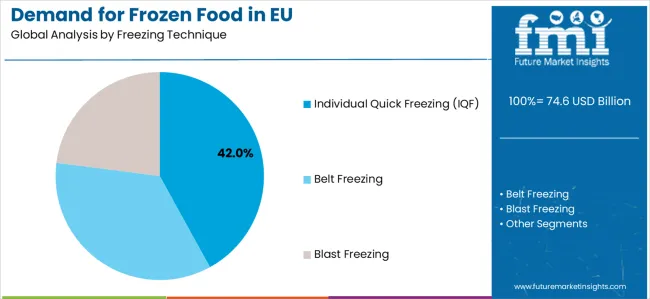
Individual quick freezing (IQF) segment is projected to account for 42.0% of the demand for frozen food in EU in 2025, establishing itself as the dominant freezing technology across European food manufacturing and processing facilities. This commanding market position is fundamentally supported by the widespread adoption of IQF technology for premium quality preservation, superior texture retention, and advanced nutritional maintenance that delivers exceptional product quality, consistent freezing performance, and superior food safety characteristics throughout large-scale commercial operations across EU member states.
IQF frozen food products provide European food manufacturers with unparalleled quality control, precise temperature management during freezing processes, enhanced product differentiation, and seamless integration with premium frozen food trends that comply with stringent EU food safety and quality directives.
This technological sophistication enables European frozen food companies to achieve optimal production economics while maintaining rigorous quality protocols mandated by European Food Safety Authority (EFSA) regulations, comprehensive traceability systems required under EU law, and consistent quality performance across millions of individual frozen food applications produced annually.
The segment derives substantial competitive advantages from established European IQF processing infrastructure offering specialized equipment solutions, comprehensive technical support services, and continuous technology innovation that incorporates enhanced freezing efficiency, improved energy utilization, and advanced automation capabilities aligned with Industry 4.0 standards. The IQF systems deliver superior premium positioning particularly important in quality-conscious markets, enhanced product appeal, improved consumer satisfaction, and superior regulatory compliance with EU food processing standards.
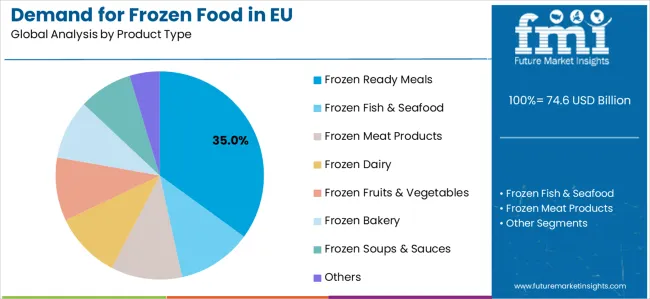
Frozen ready meals applications are positioned to represent 35.0% of total European frozen food demand in 2025, reflecting the segment's dominant position within the market ecosystem and the substantially larger convenience food consumption patterns compared to other frozen categories across most European countries. This substantial market share directly demonstrates the exceptionally high adoption rates of ready meal solutions among European consumers and the continuously expanding population of time-conscious households and working professionals across both Western and Eastern European markets.
Modern European frozen ready meal applications are increasingly featuring sophisticated formulations that deliver enhanced nutritional profiles, extended shelf life characteristics, and specialized convenience properties specifically designed to address common lifestyle challenges including meal preparation time constraints, nutritional balance requirements, portion control needs, and culinary variety preferences.
European consumers consistently demonstrate willingness to invest substantially in premium frozen ready meal products that deliver visible convenience benefits, support optimal nutritional outcomes, comply with EU food safety standards, and provide consistent results for both home consumption and professional food service operations. Within the frozen ready meals segment, premium gourmet meals command growing market share, health-focused options represent significant adoption, and ethnic cuisine varieties account for expanding consumer interest, reflecting comprehensive segmentation strategies tailored to European market preferences.
The demand for frozen food in EU is advancing steadily due to intensifying urbanization trends and growing consumer preference for convenient meal solutions across EU member states. The market faces challenges including fluctuating energy costs for cold chain operations and storage facilities, complex supply chain logistics requirements for temperature-controlled distribution across diverse European geographies, varying consumer perception challenges regarding processed versus fresh food alternatives, competition from emerging meal kit services and fresh convenience alternatives, and varying sustainability concerns across different EU countries regarding packaging and energy consumption.
Green Deal initiatives, sustainable packaging programs, energy-efficient freezing technologies, and premium quality positioning continue to influence product development strategies and market evolution patterns across European markets.
The rapidly accelerating adoption of convenience-driven lifestyles and time-saving meal solutions is fundamentally enabling broader market penetration across European countries, enhanced consumer acceptance of frozen alternatives particularly regarding nutritional equivalency, and significantly improved product quality through advanced freezing technology integration.
Advanced convenience food education programs operated by specialized nutritionists, professional dietary counsellors, and major food manufacturers equipped with comprehensive nutritional guidance in multiple European languages, consumer testimonials, preparation guides, and meal planning recommendations provide extensive educational resources while dramatically expanding product visibility across diverse time-conscious segments and geographic markets throughout the European Union.
These lifestyle trends prove particularly valuable for frozen food products that require detailed preparation instructions, nutritional benefit education, and targeted marketing approaches to effectively communicate convenience advantages and justify premium pricing positions across sophisticated European household segments.
Convenience lifestyle adoption also enables sophisticated consumer behaviour analytics, personalized meal recommendations based on individual dietary needs and time constraints, direct consumer feedback collection that informs product development, and subscription models that ensure predictable revenue streams while reducing customer acquisition costs across fragmented European markets.
Progressive European frozen food manufacturers are systematically incorporating innovative freezing technologies including advanced IQF systems, energy-efficient processing methods, packaging innovation, and nutritional preservation techniques that address growing European consumer demands for superior quality, enhanced nutritional retention, and sustainable processing in frozen food products.
Strategic integration of these advanced freezing technologies, combined with rigorous quality testing and nutritional validation protocols conducted at European food technology institutions, enables manufacturers to develop differentiated product propositions that appeal to quality-conscious European consumers while maintaining essential convenience characteristics and competitive pricing.
These technological initiatives also support development of specialized formulations for specific dietary applications increasingly recognized across European markets, enhanced shelf stability options for extended distribution efficiency recommended by European retailers, and premium-quality products that resonate with health-driven consumer segments particularly prevalent in Nordic and Western European countries.
Technology investments in advanced freezing facilities established in Netherlands and Germany, precision temperature control capabilities, and state-of-the-art frozen food processing technologies enable European manufacturers to explore next-generation convenience products while maintaining competitive positioning in premium and mainstream market segments.
European consumers and food retailers are increasingly prioritizing sustainable packaging solutions and environmental responsibility when selecting frozen food products, driving fundamental changes in packaging strategies across the European frozen food industry. Companies are implementing comprehensive sustainable packaging systems using recyclable and biodegradable materials, reducing environmental impact through energy-efficient freezing methods and renewable energy utilization, and developing fully traceable supply chains that align with EU Green Deal directives and circular economy regulations.
This trend is particularly pronounced across Nordic countries, Germany, Netherlands, and France where consumers demonstrate exceptional environmental consciousness and willingness to pay premiums for products with verified sustainability credentials and eco-friendly packaging solutions.
Manufacturers are responding by developing partnerships with sustainable packaging suppliers, implementing circular economy programs, obtaining multiple environmental certifications including EU Ecolabel and sustainable sourcing standards, and providing transparent environmental impact information that differentiates their products in increasingly competitive European markets emphasizing environmental responsibility and sustainable consumption patterns.
The demand for frozen food in EU is projected to grow from USD 74.6 billion in 2025 to USD 125 billion by 2035, registering a CAGR of 5.3% over the forecast period. France is expected to maintain market leadership with a 28.5% share in 2025, supported by its extensive culinary tradition and strong frozen food retail infrastructure.
Germany follows closely with a 28.0% market share, attributed to robust consumer demand for convenience foods and premium frozen products. The Rest of Europe contributes 43.4% of the market, driven by rapid expansion in Eastern European economies and growing frozen food adoption across diverse national markets. Spain accounts for significant growth potential, while Italy represents steady market development.
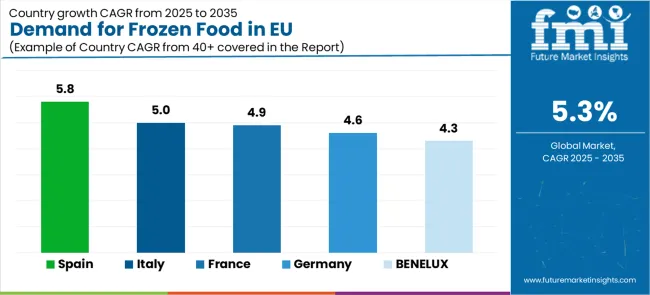
| Country/Region | CAGR (2025-2035) |
|---|---|
| Spain | 5.8 |
| Italy | 5.0 |
| France | 4.9 |
| Germany | 4.6 |
| BENELUX | 4.3 |
The demand for frozen food in EU demonstrates robust growth across major economies, with Spain leading at a 5.8% CAGR through 2035, driven by rapidly expanding urbanization and growing consumer acceptance of convenience foods. Italy follows at 5.0%, supported by increasing integration of frozen products into traditional Italian household consumption patterns. France maintains steady growth at 4.9%, leveraging its established frozen food retail infrastructure and culinary innovation trends. Germany records consistent growth at 4.6%, emphasizing quality and premium product development. BENELUX maintains moderate growth at 4.3%, focusing on sustainable and premium frozen food preferences.
The frozen food industry in France is projected to exhibit strong growth with a CAGR of 4.9% through 2035, driven by exceptionally strong French culinary tradition adapted to modern convenience needs, comprehensively well-established retail networks for premium frozen products, and sophisticated consumer preferences supporting quality and innovation throughout the country.
France's advanced food safety regulations and internationally recognized culinary standards through organizations, including the French National Institute for Agricultural Research, are creating substantial demand for premium frozen food products across diverse consumer and professional segments. Major retail chains including Carrefour, Auchan, Leclerc, specialized frozen food retailers including Picard Surgelés, and professional distribution networks are systematically establishing extensive frozen product portfolios serving both discerning consumers and commercial food service operations throughout French urban centers, suburban areas, and rural regions.
The French market benefits from exceptionally high consumer appreciation for culinary quality, substantial premium frozen food retail presence, strong private label programs delivering gourmet quality at competitive price points, and cultural emphasis on food excellence that naturally supports premium frozen food adoption.
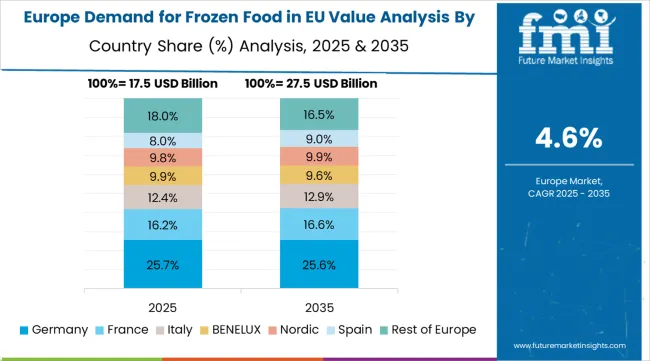
The frozen food industry in Germany is expanding at a steady CAGR of 4.6%, substantially supported by strong German consumer preference for quality and reliability in food products, rapidly growing acceptance of convenience solutions among German households, and sophisticated appreciation for technological innovation in food processing reflecting German industrial excellence.
Germany's well-established quality standards and premium positioning strategies across retail sectors are systematically driving demand for high-quality frozen food products across diverse household and commercial segments. Major retail chains including REWE, EDEKA, Aldi, Lidl, specialized organic retailers including Alnatura, and professional distribution networks are establishing comprehensive product ranges featuring premium domestic and imported frozen foods emphasizing quality certification and nutritional transparency.
The German market particularly benefits from strong cultural emphasis on quality assurance, technological innovation in food processing, and systematic approach to nutrition that align perfectly with premium frozen food positioning as reliable convenience solutions with maintained nutritional value.
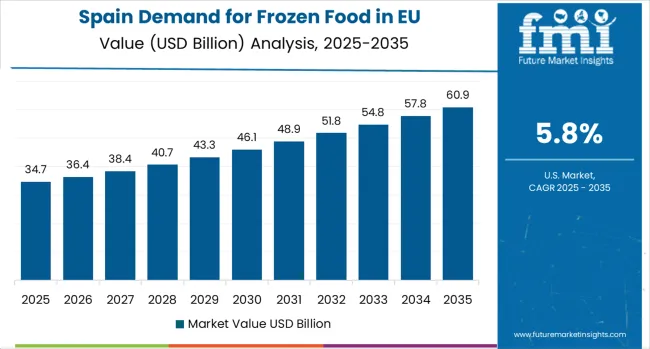
The frozen food industry in Spain is growing at the highest CAGR of 5.8%, fundamentally driven by rapid lifestyle modernization across Spanish urban areas, growing acceptance of convenience foods among traditional Spanish households, and strong economic recovery supporting increased consumer spending on premium food products. Spain's evolving food culture is actively incorporating frozen food solutions to complement traditional cooking methods, improve meal planning efficiency, and modernize Spanish dietary patterns while maintaining authentic regional flavors and culinary traditions.
Major retail chains including Mercadona, Carrefour España, Día, El Corte Inglés, and regional supermarket networks are strategically investing in frozen food category expansion and consumer education addressing growing Spanish interest in convenience solutions. The Spanish market particularly benefits from strong economic growth particularly in major metropolitan areas, cultural appreciation for food innovation when maintaining traditional flavors, and growing dual-income household adoption supporting premium convenience product consumption.
Demand for frozen food in Italy is projected to grow at a solid CAGR of 5.0%, substantially supported by gradual integration of convenience solutions into Italian culinary traditions, increasing consumer acceptance of quality frozen products, and growing Italian household adoption of meal planning and time-efficient cooking methods particularly in Northern Italian metropolitan areas including Milan, Turin, Rome, and Naples.
Italian frozen food sector is experiencing modernization with expansion of quality-focused retailers, premium frozen product suppliers, and major grocery chains (Coop, Esselunga, Conad, Carrefour Italia) systematically increasing frozen category investments and introducing premium frozen food selections emphasizing Italian ingredients and traditional flavors.
The Italian market is increasingly characterized by quality-first approaches reflecting broader Italian food culture values, growing interest in frozen products that maintain traditional Italian taste profiles, and increasing acceptance of convenience solutions that support Italian family meal traditions. Italy's substantial culinary heritage, strong cultural appreciation for food authenticity, and expanding working population create favorable conditions for quality frozen food industry expansion.
Demand for frozen food in BENELUX is expanding at a steady CAGR of 4.3%, fundamentally driven by strong regional consumer commitment to premium quality and sustainable food products, sophisticated frozen food retail infrastructure, and environmental consciousness that positions BENELUX among European sustainability leaders. BENELUX consumers and retail operators are increasingly selecting frozen foods based on comprehensive quality certifications, verified sustainable production methods, and complete supply chain transparency documenting environmental impact and ethical sourcing practices throughout freezing and distribution processes.
The BENELUX market significantly benefits from exceptionally well-developed premium retail channels, including Albert Heijn, Jumbo, Delhaize, specialized premium retailers, and professional food service suppliers, combined with a demonstrated willingness to pay substantial premiums for products with verified quality certifications and sustainability standards. BENELUX regulatory environment actively supports sustainable food production, energy-efficient cold chain operations, transparent labeling requirements, and circular economy initiatives that enhance consumer confidence and market development.
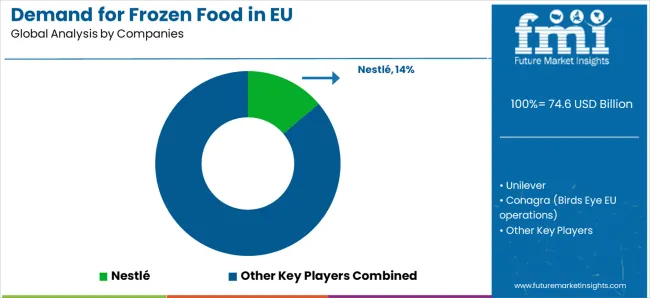
The demand for frozen food in EU is defined by intense competition among multinational food corporations, regional European manufacturers, specialty frozen food producers, and private label suppliers from major retail chains. Companies are investing in European manufacturing capacity expansion, advanced freezing technology development, sustainable packaging programs through European environmental standards, cold chain optimization solutions aligned with EU energy efficiency directives, and omnichannel distribution platforms serving diverse European consumer and commercial markets.
Strategic acquisitions, product portfolio diversification, geographic market expansion across Eastern European growth markets, retail partnership programs, and sustainability certifications are central to strengthening market position and capturing share in this highly competitive European category.
Major market participants include Nestlé with significant European market presence through comprehensive frozen food solutions and large-scale manufacturing capabilities operated at European facilities including Switzerland, Germany, and France. Unilever maintains substantial European market leadership through premium frozen meal brands and diverse product applications across consumer and food service markets. Conagra (Birds Eye EU operations) represents established European market presence through mainstream frozen food products and competitive market positioning.
Nomad Foods (Findus, Iglo, Birds Eye EU) emphasizes European-focused frozen food leadership and comprehensive brand portfolio serving diverse European markets. General Mills maintains growing European presence through branded frozen snacks and meal solutions targeting premium market segments.
Regional European producers and specialized frozen food brands are establishing significant market presence through premium quality positioning, sustainable production practices, specialty product formulations including organic and health-focused varieties, and direct retail partnership models.
Private label programs from major European retail chains including Carrefour, REWE, Tesco, and regional grocery networks provide quality alternatives at competitive pricing, capturing meaningful market share particularly in value-conscious consumer segments. European co-manufacturing specialists including specialized frozen food producers operate large-scale production facilities serving both branded manufacturers and private label customers, representing critical infrastructure enabling market expansion and product innovation across European frozen food industry.
| Item | Value |
|---|---|
| Quantitative Units | USD 125 billion |
| Freezing Technique | Individual Quick Freezing (IQF), Belt Freezing, Blast Freezing |
| Product Type | Frozen Ready Meals, Frozen Fish & Seafood, Frozen Meat Products, Frozen Dairy, Frozen Fruits & Vegetables, Frozen Bakery, Frozen Soups & Sauces, Others |
| Distribution Channel | Supermarkets/Hypermarkets, Specialty Stores, Foodservice Operators, Online Retail |
| Countries Covered | Germany, France, Italy, Spain, BENELUX, Rest of Europe |
| Key Companies Profiled | Nestlé, Unilever, Conagra (Birds Eye EU operations), Nomad Foods (Findus, Iglo, Birds Eye EU), General Mills, McCain Foods, Dr. Oetker, Picard Surgelés, Frosta AG, Iglo Group |
| Additional Attributes | Dollar sales by freezing technique, product type, and distribution channel, regional demand trends across Western and Eastern European markets, competitive landscape analysis with multinational corporations and regional European brands, consumer preferences for premium versus value-oriented products and sustainability programs, integration with European convenience lifestyle trends and meal planning strategies, innovations in freezing technologies and sustainable packaging solutions aligned with EU Green Deal directives, adoption of omnichannel retail and cold chain optimization models across EU markets, regulatory framework analysis and food safety standards, supply chain optimization strategies including European manufacturing partnerships, and market penetration analysis for diverse consumer segments and geographic regions throughout European Union member states. |
The global demand for frozen food in EU is estimated to be valued at USD 74.6 billion in 2025.
The market size for the demand for frozen food in EU is projected to reach USD 125.5 billion by 2035.
The demand for frozen food in EU is expected to grow at a 5.3% CAGR between 2025 and 2035.
The key product types in demand for frozen food in EU are individual quick freezing (iqf), belt freezing and blast freezing.
In terms of product type, frozen ready meals segment to command 35.0% share in the demand for frozen food in EU in 2025.






Our Research Products

The "Full Research Suite" delivers actionable market intel, deep dives on markets or technologies, so clients act faster, cut risk, and unlock growth.

The Leaderboard benchmarks and ranks top vendors, classifying them as Established Leaders, Leading Challengers, or Disruptors & Challengers.

Locates where complements amplify value and substitutes erode it, forecasting net impact by horizon

We deliver granular, decision-grade intel: market sizing, 5-year forecasts, pricing, adoption, usage, revenue, and operational KPIs—plus competitor tracking, regulation, and value chains—across 60 countries broadly.

Spot the shifts before they hit your P&L. We track inflection points, adoption curves, pricing moves, and ecosystem plays to show where demand is heading, why it is changing, and what to do next across high-growth markets and disruptive tech

Real-time reads of user behavior. We track shifting priorities, perceptions of today’s and next-gen services, and provider experience, then pace how fast tech moves from trial to adoption, blending buyer, consumer, and channel inputs with social signals (#WhySwitch, #UX).

Partner with our analyst team to build a custom report designed around your business priorities. From analysing market trends to assessing competitors or crafting bespoke datasets, we tailor insights to your needs.
Supplier Intelligence
Discovery & Profiling
Capacity & Footprint
Performance & Risk
Compliance & Governance
Commercial Readiness
Who Supplies Whom
Scorecards & Shortlists
Playbooks & Docs
Category Intelligence
Definition & Scope
Demand & Use Cases
Cost Drivers
Market Structure
Supply Chain Map
Trade & Policy
Operating Norms
Deliverables
Buyer Intelligence
Account Basics
Spend & Scope
Procurement Model
Vendor Requirements
Terms & Policies
Entry Strategy
Pain Points & Triggers
Outputs
Pricing Analysis
Benchmarks
Trends
Should-Cost
Indexation
Landed Cost
Commercial Terms
Deliverables
Brand Analysis
Positioning & Value Prop
Share & Presence
Customer Evidence
Go-to-Market
Digital & Reputation
Compliance & Trust
KPIs & Gaps
Outputs
Full Research Suite comprises of:
Market outlook & trends analysis
Interviews & case studies
Strategic recommendations
Vendor profiles & capabilities analysis
5-year forecasts
8 regions and 60+ country-level data splits
Market segment data splits
12 months of continuous data updates
DELIVERED AS:
PDF EXCEL ONLINE
Europe Frozen Food Market Trends – Growth, Demand & Forecast 2025–2035
Frozen Food Packaging Market Size and Share Forecast Outlook 2025 to 2035
Frozen Food Packaging Machines Market Size and Share Forecast Outlook 2025 to 2035
Frozen Food Market Analysis - Size, Share, and Forecast Outlook 2025 to 2035
Europe Food Service Equipment Market Outlook – Size, Trends & Forecast 2025–2035
Europe Food Testing Services Market Analysis – Size, Share & Forecast 2025–2035
Europe Food Emulsifier Market Trends – Growth, Demand & Forecast 2025–2035
Europe Food Stabilizers Market Analysis – Size, Share & Forecast 2025–2035
Market Share Insights in the Frozen Food Industry
Comprehensive Analysis of Food Premix Market by Form, Ingredient Type, End-Use Application and Function Type through 2035
Market Share Breakdown of Frozen Food Packaging Manufacturers
Frozen Seafood Market Analysis by Nature, Form, End Use, Distribution Channel and Other Products Type Through 2035
Frozen Pet Food Market Size and Share Forecast Outlook 2025 to 2035
Europe Pet Food Market Analysis by Nature, Product Type, Source, Pet Type, Packaging, Distribution Channel, and Country - Growth, Trends, and Forecast through 2025 to 2035
Comprehensive Analysis of Europe Pet Food Supplements Market by Nature, Form, Pet Type and Distribution Channel through 2035
Europe Superfood Powder Market Analysis – Size, Share & Forecast 2025-2035
UK Frozen Food Market Growth – Size, Share & Forecast 2025–2035
USA Frozen Food Market Analysis – Demand, Trends & Forecast 2025–2035
Fast-Food Reusable Market Growth – Demand & Forecast 2025 to 2035
ASEAN Frozen Food Market Growth – Trends, Demand & Innovations 2025–2035

Thank you!
You will receive an email from our Business Development Manager. Please be sure to check your SPAM/JUNK folder too.
Chat With
MaRIA